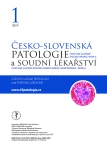Forensic aspects of communication with the patient and bereaved persons in out-of-hospital practice
Authors:
Kaniok Radek 1; Novomeský František 2; Veselá Kanioková Petra 3
Authors‘ workplace:
Oddělení Anesteziologie a Resuscitace, Městská nemocnice Ostrava, p. o. Anesteziologicko-resuscitační oddělení, Nemocnice s poliklinikou Havířov, p. o.
1; Ústav súdneho lekárstva a medicínskych expertíz, Jesseniova lekárska fakulta v Martine, Univerzita Komenského v Bratislave, Univerzitná nemocnica Martin
2; Dětské oddělení, Nemocnice s poliklinikou Karviná-Ráj, p. o.
3
Published in:
Soud Lék., 64, 2019, No. 1, p. 5-8
Category:
Original Article
Overview
It is not easy to characterize a problem patient or bereaved relatives because identifying a patient or his bereaved family as a “problem” is not considered quite ethical.
The approached emergency medical service employees and coroner service physicians were asked to complete a specific targeted anonymous survey. 100 % of survey questionnaires were returned. The questionnaire with a request for filling and returning was submitted to forty employees working full-time, twenty of whom were physicians, ten paramedics and ten lower-level healthcare professionals. The questionnaire comprised ten questions aimed at obtaining clear answers to questions about personal experience with problem patients, specifically aggressive patients, and more specifically whether the health care professionals (HCP) has ever felt immediately threatened by a patient in their work, whether they were exposed to verbal or even physical attack in the context of the patient’s basic diagnosis established during pre-hospital care.
Seventy-five percent of respondents answered Yes to Question No. 5: “Have you ever felt threatened by a patient or bereaved relative in your work?” Eighty percent of respondents answered Yes to Question No. 6: “Have you ever been exposed to a verbal attack by a patient or bereaved relative?” Seventy-five percent of them answered Yes to Question No. 7: “Have you ever been exposed to a physical attack by a patient?”
The rate of cases in which emergency medical service employees are exposed to verbal or physical attacks is high.
The primary experience hypothesis that this happens has been proven as well as the fact that it is a highly topical and therefore unresolved issue that threatens the whole society with its social implications.
Keywords:
bereaved family – aggressiveness – communication – suicide – difficult patient
Sources
- Andršová A. Psychologie a komunikace pro záchranáře: v praxi. Praha: Grada, 2012.
- Matoušková I., Spurný J. Komunikačně náročné situace v policejní praxi. Plzeň: Vydavatelství a nakladatelství Aleš Čeněk, 2005.
- Čírtková L. Policejní psychologie. 2., rozšířené vydání. Plzeň: Vydavatelství a nakladatelství Aleš Čeněk, 2015.
- Ptáček R., Bartůněk P. Etika a komunikace v medicíně. Praha: Grada, 2011.
- Kolářová L. Polaritní chování člověka a jeho formy řešení. Zlín: Univerzita Tomáše Bati ve Zlíně, 2009, 48 s.
- Janáčková L., Weiss P. Komunikace ve zdravotnické péči. Vyd. 1. Praha: Portál, 2008, 134 s.
- Praško J. Psychické problémy u somaticky nemocných a základy lékařské psychologie. 1. vyd. Olomouc: Univerzita Palackého v Olomouci, 2010, 430 s.
- Beran J. Lékařská psychologie v praxi. Vyd. 1. Praha: Grada, 2010, 140 s.
- Dvořáček I., Herle P. Soudní lékařství pro všeobecné praktické lékaře. Praha: Raabe, 2013.
- Klimeš J. Neviditelné podoby agrese. Naše psychologie [online]. 2008. http://klimes.mysteria.cz/clanky/psychologie/agrese.htm
- Vevera, J., Černý, M., Král, P. Agrese a násilné chování. Zdraví e15 [online]. 2011, č. 2.
- Čírtková L. Policejní psychologie. 2., rozšířené vydání. Plzeň: Vydavatelství a nakladatelství Aleš Čeněk, 2015.
- Couppis, MH., Kennedy, CH., Stanwood, GD. Differences in aggressive behavior and in the mesocorticolimbic DA system between A/J and BALB/cJ mice. Synapse 2008; 62 : 715-724.
- Ptáček R., Raboch J., Kebza V., Šolcová I. Syndrom vyhoření a stres v lékařských profesích in: Ptáček R., Raboch J., Kebza V a kol.: Burnout syndrom jako mezioborový jev, Grada, Praha, 2003, 168.
- David A. Scenario methodology for teaching principles of emergency management. 2.vydání. Disaster Prevention and Management 2000; 9 : 89-97
Labels
Anatomical pathology Forensic medical examiner ToxicologyArticle was published in
Forensic Medicine

2019 Issue 1
Most read in this issue
- Unusual mechanism of injury in a case of suicide by the jump from height
- Forensic aspects of communication with the patient and bereaved persons in out-of-hospital practice
- X. Mezinárodní kongres úrazové chirurgie a soudního lékařství
- Za doc. Ing. Miroslavom Bauerom, CSc.
